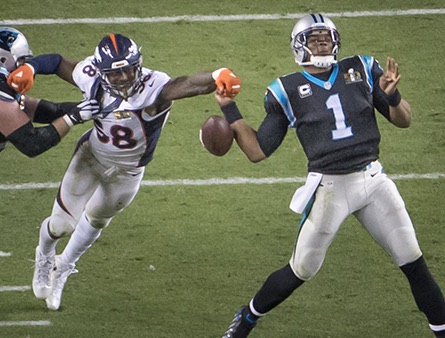Defense, Offense and OTT Competition

Recent events here in Colorado — particularly the big event involving a football team named after a type of wild horse — got me thinking about defense, offense and over-the-top video.
You don’t have to be a complete football novice (like me!) to glean that the Broncos (go Donks!) won Super Bowl 50 because of their defense — lots of sacks, lots of not letting the other guys move forward. Lots of maneuvers that make the other team’s quarterback sulk and sputter.
All of this got me thinking, as a self-professed non-sports person, about offensive and defensive strategies in the heightening faceoff between over-the-top and “traditional” video providers. And after mulling it about a dozen different ways, this is my take — with a preface that this is all highly debatable.
If you’re the OTT insurgent, your offense is the nearly complete lack of “friction,” when it comes to buying and using video. No taking time off of work to wait for an installer. If hardware comes with it (think Roku, Amazon Fire TV Stick, and their ilk), it practically self-installs. In the case of the Amazon Fire TV Stick, for instance, it arrives pre-provisioned to your purchasing credentials; your user name pops up the moment it’s plugged in and finds signal.
WORKING AT ‘WEB SPEED’
And if you’re the OTT competitor, you probably already work at “Web speed,” which is a couple ticks higher than “cable speed.” There’s a “mobile speed,” which is faster than Web speed. This is all measured in software releases, and how quickly they’re “dropped” to connected devices. It’s a cultural thing, fueled by cultural techniques like “agile” computing and “DevOps,” the tight collaboration between product developers and operations people.
If you’re the OTT guy, your defense is the mere fact that you’re already “all-IP,” where “IP” stands for Internet protocol. It’s called “over the top,” after all, because its traffic and services run on top of the world’s pre-existing broadband connections, which are natively IP. If “all-IP” is the end game for the video incumbents, it’s table stakes for OTT.
The smarter way to stay on top of broadcasting and cable industry. Sign up below
If you’re the traditional subscription video player — and in particular, the industry we used to call “cable” — your defense is probably your bandwidth. That’s your raw capacity — which everybody else rides upon, yes, but it’s probably time to get over it. Bandwidth and capacity ruled the roost ever since those early, early days, a half-century ago, when people wondered if we’d ever really need more than 12 channels. It still does.
And your offense? The move to all-IP, for starters, which opens all the doors the OTT community already opened and entered. But if the goal line in this battle is ultimately churn reduction, then that offensive line also needs to be heavy on customer care, user experience and everything that comes with not giving customers a reason to even bat an eye at OTT alternatives.
Of course, there’s always the matter of breadth and depth of content libraries, and the glories that come with nesting more and more stuff in “the cloud,” so as to lighten dependencies on hardware in the home.
BANDWIDTH HOLDS THE LINE
When the Broncos won the Super Bowl, it was “offense is fun, but defense wins championships,” and “the best offense is a good defense.” But in the real world of video competition, it’s not quite so tidy. If bandwidth is the defense, the industry is in pretty good shape, what with DOCSIS 3.1, fiber deep, advanced compression, and everything else that expands what is a growing capacity footprint.
The trick now is to up the game on all-IP, and everything that flows from it — while retooling the ranks to work at “Web speed.” This is happening, but it’s painful — not unlike fixing the jet plane while it’s flying.
